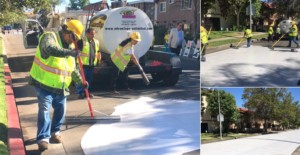
LA street workers paint the city’s streets white.
Credit: LA Street Services
We already know that the urban heat island effect can significantly increase temperatures and worsen heat waves, even in neighboring cities. But what can communities do about it?
Cities like Louisville, Kentucky, have already been exploring large-scale tree planting as a way to cut down on heat build up, now LA is unleashing another potential tool against urban warming:
They are painting some of their streets—trial roads in all 15 council districts to be precise—white. (Actually, it’s more like an off-white/gray—but the principle is the same.) By covering blacktop asphalt with a more reflective “cool pavement” treatment, LA Street Services claims they’ll reduce temperatures on a summer afternoon by ten degrees or more. In fact, Curbed Los Angeles reports that a similar scheme in Encino reduced surface temperature on a parking lot by a whopping 25 to 30 degrees.
Of course, immediate localized surface temperatures are probably less important than how the build up of heat on hard surfaces impacts the overall urban microclimate, and associated energy use. […]











This is a great effort, and could help more trees to grow, which would further reduce temperature. Unfortunately, most climate modeling I’ve seen for the Southwest has temperatures rising to unbearable levels within a few decades. This will happen while both a) current water supplies end, and b) fossil fuel supplies end. Los Angeles will not thrive with 130F, no water, and no gasoline, and we will see masses leave LA, Phoenix, and the rest of the Southwest for more comfortable areas.
Great idea! Streets and parking lots create warmer mini climate pockets. All roof should be white, unless a better idea shows up. I think we’ll see more great technological ideas for recycling and conserving water. It’s my understanding that hydroponic farming takes 70% less water than traditional ways. There are still so many big ag farms using the old sprinkler systems which waste a lot. The Israeli’s are experts on water farming water conservation and drip systems are an important part of that. It’s going to be interesting to see the advances they’re making on tower farming and underground gardens go even further. A large number of restaurants in NYC have their own organic gardens underground.